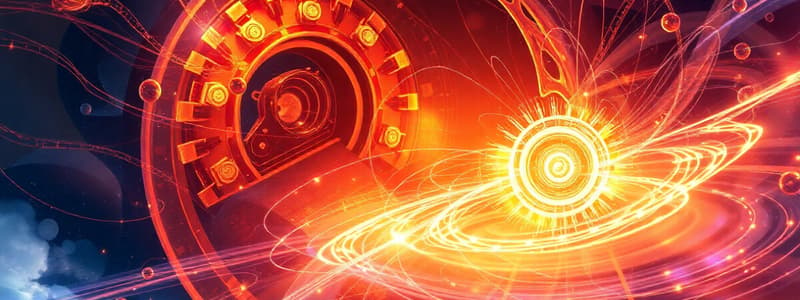Podcast
Questions and Answers
กระบวนการเรียกว่า diffraction มีความหมายอย่างไร?
กระบวนการเรียกว่า diffraction มีความหมายอย่างไร?
- การสะท้อนของแสงบนกระจก
- การกระจายของแสงเมื่อผ่านช่องหรือรอบสิ่งกีดขวาง (correct)
- การรวมตัวของคลื่นเสียง
- การทำลายของแสงเมื่อผ่านวัตถุทึบ
ทฤษฎีสัมพัทธภาพทั่วไปอธิบายอะไรเกี่ยวกับแรงโน้มถ่วง?
ทฤษฎีสัมพัทธภาพทั่วไปอธิบายอะไรเกี่ยวกับแรงโน้มถ่วง?
- แรงโน้มถ่วงเป็นการบิดเบือนของระนาบเวลาของอวกาศ (correct)
- แรงโน้มถ่วงเกิดจากการดึงดูดระหว่างอิเล็กตรอน
- แรงโน้มถ่วงเป็นลักษณะของการกระจายคลื่น
- แรงโน้มถ่วงเกิดจากมวลของวัตถุ
คอนเซ็ปต์ใดที่ไม่ใช่ของกลศาสตร์ควอนตัม?
คอนเซ็ปต์ใดที่ไม่ใช่ของกลศาสตร์ควอนตัม?
- การเก็บรักษาพลังงาน (correct)
- ดูอัลิตี้ของคลื่นและอนุภาค
- การควอนไทซ์ของพลังงาน
- ความไม่แน่นอน
ตามทฤษฎีสัมพัทธภาพพิเศษ การเคลื่อนที่ที่มีความเร็วคงที่หมายถึงอะไร?
ตามทฤษฎีสัมพัทธภาพพิเศษ การเคลื่อนที่ที่มีความเร็วคงที่หมายถึงอะไร?
การนำทฤษฎีสัมพัทธภาพไปใช้มีผลกระทบต่อการเข้าใจเรื่องใด?
การนำทฤษฎีสัมพัทธภาพไปใช้มีผลกระทบต่อการเข้าใจเรื่องใด?
กฎข้อใดของนิวตันระบุว่า วัตถุที่อยู่เฉยจะยังคงอยู่เฉย และวัตถุที่เคลื่อนที่จะยังคงเคลื่อนที่ต่อไปโดยไม่มีการเปลี่ยนแปลงถ้าไม่มีแรงที่ไม่สมดุลกระทำต่อ?
กฎข้อใดของนิวตันระบุว่า วัตถุที่อยู่เฉยจะยังคงอยู่เฉย และวัตถุที่เคลื่อนที่จะยังคงเคลื่อนที่ต่อไปโดยไม่มีการเปลี่ยนแปลงถ้าไม่มีแรงที่ไม่สมดุลกระทำต่อ?
สมการ $F = ma$ แสดงถึงแนวคิดใดในฟิสิกส์?
สมการ $F = ma$ แสดงถึงแนวคิดใดในฟิสิกส์?
กฎข้อใดของเทอร์โมไดนามิกส์ระบุว่าว่า พลังงานไม่สามารถถูกสร้างหรือทำลายได้?
กฎข้อใดของเทอร์โมไดนามิกส์ระบุว่าว่า พลังงานไม่สามารถถูกสร้างหรือทำลายได้?
พลศาสตร์ของไหล เช่น โลหะร้อนอยู่ภายใต้กฎของเทอร์โมไดนามิกส์ข้อใด?
พลศาสตร์ของไหล เช่น โลหะร้อนอยู่ภายใต้กฎของเทอร์โมไดนามิกส์ข้อใด?
แรงดันไฟฟ้าและกระแสไฟฟ้ามีความสัมพันธ์อย่างไรในวงจรกระแสตรง?
แรงดันไฟฟ้าและกระแสไฟฟ้ามีความสัมพันธ์อย่างไรในวงจรกระแสตรง?
อะไรคือหลักการของการหักเหของแสง?
อะไรคือหลักการของการหักเหของแสง?
เมื่อพูดถึงแม่เหล็กไฟฟ้า แรงแม่เหล็กทำงานบนสิ่งใด?
เมื่อพูดถึงแม่เหล็กไฟฟ้า แรงแม่เหล็กทำงานบนสิ่งใด?
การกระจายสีของแสงเกิดจากการกระทำใด?
การกระจายสีของแสงเกิดจากการกระทำใด?
Flashcards
การเลี้ยวเบน
การเลี้ยวเบน
แสงกระจายออกไปเมื่อผ่านช่องแคบหรือสิ่งกีดขวาง
กลศาสตร์ควอนตัม
กลศาสตร์ควอนตัม
ศึกษาเรื่องของพลังงานและสสารในระดับอะตอมและย่อยอะตอม
ทฤษฎีสัมพัทธภาพ
ทฤษฎีสัมพัทธภาพ
อธิบายความสัมพันธ์ระหว่างเวลาและอวกาศ
ทฤษฎีสัมพัทธภาพพิเศษ
ทฤษฎีสัมพัทธภาพพิเศษ
Signup and view all the flashcards
ทฤษฎีสัมพัทธภาพทั่วไป
ทฤษฎีสัมพัทธภาพทั่วไป
Signup and view all the flashcards
กลศาสตร์คลาสสิกคืออะไร?
กลศาสตร์คลาสสิกคืออะไร?
Signup and view all the flashcards
กฎการเคลื่อนที่ข้อแรกของนิวตันคืออะไร?
กฎการเคลื่อนที่ข้อแรกของนิวตันคืออะไร?
Signup and view all the flashcards
กฎการเคลื่อนที่ข้อสองของนิวตันคืออะไร?
กฎการเคลื่อนที่ข้อสองของนิวตันคืออะไร?
Signup and view all the flashcards
กฎการเคลื่อนที่ข้อสามของนิวตันคืออะไร?
กฎการเคลื่อนที่ข้อสามของนิวตันคืออะไร?
Signup and view all the flashcards
เทอร์โมไดนามิกส์คืออะไร
เทอร์โมไดนามิกส์คืออะไร
Signup and view all the flashcards
กฎข้อแรกของเทอร์โมไดนามิกส์คืออะไร?
กฎข้อแรกของเทอร์โมไดนามิกส์คืออะไร?
Signup and view all the flashcards
กฎข้อสองของเทอร์โมไดนามิกส์คืออะไร?
กฎข้อสองของเทอร์โมไดนามิกส์คืออะไร?
Signup and view all the flashcards
กฎข้อสามของเทอร์โมไดนามิกส์คืออะไร?
กฎข้อสามของเทอร์โมไดนามิกส์คืออะไร?
Signup and view all the flashcards
Study Notes
Classical Mechanics
- Classical mechanics describes the motion of macroscopic objects.
- It is based on Newton's laws of motion.
- Newton's first law states that an object at rest stays at rest and an object in motion stays in motion with the same speed and in the same direction unless acted upon by an unbalanced force.
- Newton's second law states that the acceleration of an object is directly proportional to the net force acting on it and inversely proportional to its mass. (F = ma)
- Newton's third law states that for every action, there is an equal and opposite reaction.
- Concepts like momentum, energy, and work are central to classical mechanics.
- Applications of classical mechanics include analyzing the motion of planets, designing machines, and understanding projectile motion.
Thermodynamics
- Thermodynamics deals with heat, work, and temperature, and their relationship to energy.
- Key concepts include temperature, heat, work, internal energy, entropy, and the laws of thermodynamics.
- The first law of thermodynamics states that energy cannot be created or destroyed, only transformed from one form to another.
- The second law of thermodynamics states that the total entropy of an isolated system can only increase over time.
- The third law of thermodynamics states that the entropy of a system approaches a constant value as the temperature approaches absolute zero.
- Applications of thermodynamics include understanding engines, refrigerators, and other heat-related processes.
Electricity and Magnetism
- Electricity and magnetism are closely related phenomena.
- Electric charges create electric fields.
- Moving charges create magnetic fields.
- Magnetic fields exert forces on moving charges.
- Electric currents produce magnetic fields, and changing magnetic fields can produce electric currents.
- Key concepts include electric fields, electric potential, electric circuits, magnetic fields, and electromagnetic induction.
- Applications include generating electricity, designing motors and generators, and understanding electronic devices.
Optics
- Optics deals with the behavior of light.
- Light can be modeled as waves or particles.
- Reflection describes how light bounces off surfaces.
- Refraction describes how light bends when it passes from one medium to another.
- Dispersion describes how different colors of light are separated by refraction.
- Interference describes the interaction of light waves.
- Diffraction describes the spreading of light waves as they pass through an opening or around an obstacle.
- Applications include designing lenses, mirrors, and optical instruments like telescopes and microscopes.
Modern Physics
- Modern physics includes quantum mechanics and relativity.
- Quantum mechanics describes the behavior of matter and energy at the atomic and subatomic levels.
- Key concepts include quantization of energy, wave-particle duality, and uncertainty principle.
- Relativity describes the relationship between space and time.
- Einstein's theory of special relativity states that the laws of physics are the same for all observers in uniform motion, and that the speed of light is constant for all observers.
- Einstein's theory of general relativity describes gravity as a curvature of spacetime.
- Applications include understanding atomic structure, nuclear reactions, and the behavior of black holes.
Studying That Suits You
Use AI to generate personalized quizzes and flashcards to suit your learning preferences.




